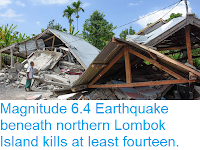A total of 373 people have now been confirmed dead, with 1459 injured and 128 still missing, after a tsunami in the Sunda Strait hit the shores of Java and Sumatra without warning on Saturday 22 December 2018. The event has been linked to a major volcanic eruption on Anak Krakatau the previous day, which is thought to have destabilised the (submerged) flanks of the volcano, which then collapsed in a submarine landslide, triggering the tsunami.
Debris on Carita Beach in Batan Province, Java, following the 23 December 2018 Sunda Strait tsunami. Reuters.
Tsunamis occur when large volumes of water are displaced by geological events, such as landslips or Earthquakes, forming waves which spread out through the surrounding ocean. Like other waves, tsunamis are not necessarily obvious in deep, open waters, but when they reach shallow or enclosed waterways can be extremely dangerous. This is because a tsunami isn't just a wave above the normal sea-level, it is pressure wave beneath the surface, which is amplified in the enclosed space. A tsunami reaching the shore is typically
preceded and followed by rapidly shallowing water. Thus people in areas
prone to tsunamis know to evacuate the coast rapidly if the tide
apparently goes out rapidly, since this is likely to be followed by the
tide coming in rapidly. This gives us the English term 'tidal wave'
which is no longer used, since it is inaccurate; the tides are caused by
the gravity of the sun and moon, tsunamis are nothing to do with the
tide. The term 'tsunami' comes from Japan, where earthquakes, and
therefore tsunamis, are common.
How a landslip can trigger a tsunami. University of California, Santa Cruz/BBC.
Krakatau is a volcanic island located in the Sunda Strait between
Sumatra and Java. The volcano famously exploded in 1883, killing over 36
000 people (possibly over 120 000), largely through a series of
tsunamis. This explosion more-or-less completely destroyed the island,
but since then a new volcano, sometimes called Anak Krakatau, has grown
in its place. Anak Krakatau is almost never completely quiet, but goes through periods of greater and lesser activity.
Eruption on Anak Krakatau on 23 December 2018. Nurul Hidayat/Bisnis Indonesia/Antara Foto/Reuters.
Krakatau is located to the north of the Sunda Trench, along which the
Australian Plate is being subducted beneath the Sunda Plate, on which
the island sits. As the Australian Plate is subducted it is partially
melted by the friction and the heat of the planet's interior. Some of
this melted material then rises through the overlying Sunda Plate,
fuelling Krakatau and the volcanoes of Sumatra and Java.
The Subduction zone beneath Sumatra. NASA/Earth Observatory.
See also...
Follow Sciency Thoughts on Facebook.










